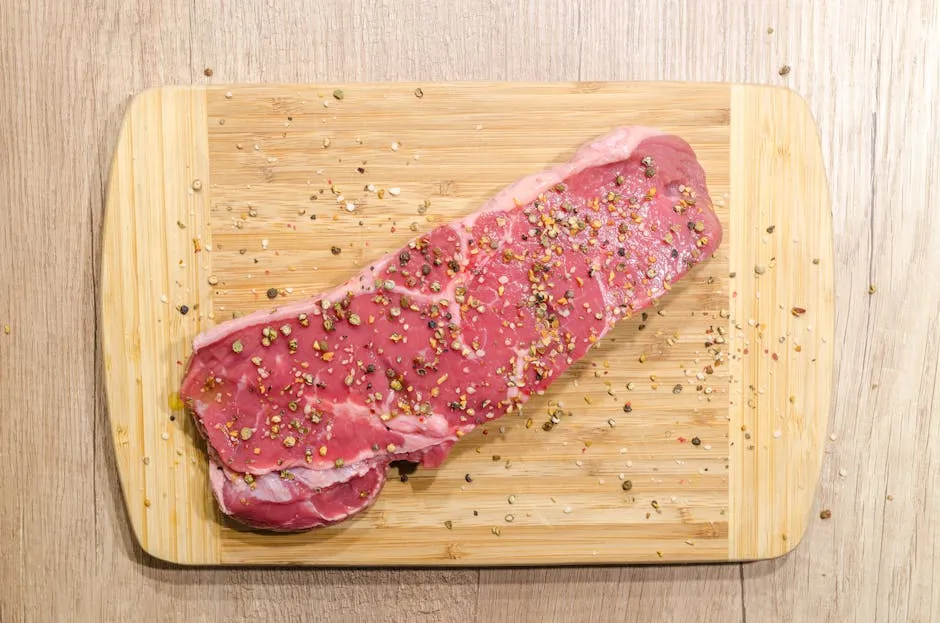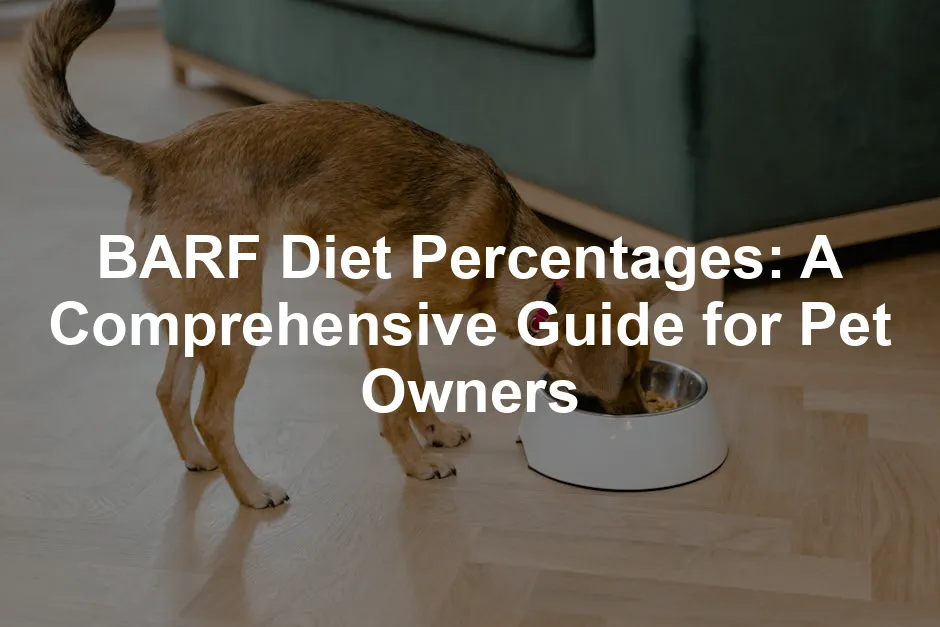Introduction
The BARF diet, or Biologically Appropriate Raw Food, is increasingly popular among dog owners. This diet focuses on feeding pets raw, natural ingredients, mimicking what their ancestors might have eaten. Understanding the correct percentages in a BARF diet is crucial for ensuring balanced nutrition for your furry friend.
To get started on this nutritional journey, grab a Raw Dog Food Recipe Cookbook that will provide you with a trove of delicious and nutritious recipes for your pooch. It’s like a Michelin-star restaurant for dogs, minus the snooty waiters!
Summary and Overview
The BARF diet is built on the philosophy that dogs thrive on a diet similar to what they would find in the wild. This approach emphasizes raw meat, bones, fruits, and vegetables while eliminating processed foods. A well-structured BARF diet typically consists of specific percentages: 70% muscle meat, 10% raw bones, 5% liver, 5% other organs, 7% vegetables, 2% seeds or nuts, and 1% fruit. These ratios play a vital role in maintaining a dog’s health and well-being. They provide essential nutrients that support energy levels, immune function, and overall vitality. Understanding and adhering to these key percentages can help ensure your dog enjoys a healthier, more fulfilling life.

For a comprehensive understanding of the BARF diet, check out this BARF diet for dogs.
Understanding the BARF Diet
What Does BARF Stand For?
BARF stands for Biologically Appropriate Raw Food or Bones and Raw Food. It emphasizes using whole, unprocessed foods. The main components include raw muscle meat, meaty bones, fruits, and vegetables. These ingredients aim to mimic a natural diet that dogs would consume in the wild.
Importance of Raw Feeding
Raw feeding is based on the belief that dogs are carnivores at heart. This diet offers numerous benefits over commercial dog food. For instance, raw diets are free from fillers and artificial ingredients. They often lead to improved digestion, healthier skin, and shinier coats. Additionally, many pet owners report better energy levels and reduced allergies in their dogs. Choosing a natural diet like BARF can significantly enhance your dog’s health and happiness.
To make feeding your dog easier, consider investing in a reliable Dog Food Storage Container. This keeps your dog’s food fresh and free from pests, so you can say goodbye to those pesky pantry invaders! Plus, it adds a touch of organization to your pet care routine.

BARF Diet Model Ratio Guidelines
When it comes to the BARF diet, understanding the correct ratios is key to your dog’s health. Here’s a breakdown of the standard ratios for adult dogs:
Standard Ratios for Adult Dogs
– 70% Muscle Meat: This is the cornerstone of the BARF diet. Muscle meat provides essential protein, amino acids, and water-soluble vitamins. Incorporating a variety of meats, such as beef, chicken, and lamb, ensures a well-rounded nutrient profile. This protein-rich foundation supports muscle growth and overall vitality.
– 10% Raw Edible Bone: Bones are crucial for calcium and phosphorus. They help maintain strong bones and teeth. Choose meaty bones like chicken necks or turkey wings to add variety. Adjust this ratio based on your dog’s specific needs and digestive tolerance.
– 5% Liver: Liver is a powerhouse of nutrients. It contains essential vitamins like A and B, along with minerals. Incorporating liver into your dog’s diet boosts energy levels and supports immune function. For sensitive dogs, this ratio can be reduced slightly.

For a deeper insight into raw meat diets for dogs, explore this raw meat diet dogs.
– 5% Other Organs: Various organ meats, such as kidneys and hearts, are vital. They provide unique nutrients that support overall health. Including a mix of organ meats enhances the diet’s nutritional completeness. Aim for variety to cover all essential vitamins and minerals.
– 7% Vegetables: While dogs are primarily carnivorous, vegetables offer valuable nutrients. They provide fiber, antioxidants, and essential vitamins. Prepare vegetables by lightly steaming or pureeing to enhance digestibility. Common choices include carrots, spinach, and zucchini.
– 2% Seeds or Nuts: Seeds and nuts contribute healthy fats and essential fatty acids. They can also introduce minerals and vitamins to your dog’s diet. Always soak and grind seeds like flax or chia before feeding to aid digestion.
– 1% Fruit: Fruits are packed with antioxidants but should be limited due to sugar content. Suitable options include blueberries, apples, and bananas. Introduce fruits in moderation to avoid digestive upset while still reaping their health benefits.
Following these ratios ensures your dog receives a balanced diet tailored to their nutritional needs. It’s essential to monitor their health and adjust these percentages as necessary.

Adjustments Based on Individual Needs
Every dog is unique, and their dietary needs can vary. Factors such as size, age, and health status play a significant role in determining the ideal BARF diet ratios.
For example, larger breeds often require more protein, while smaller breeds might need slightly less. Puppies generally need higher protein and fat ratios for growth, while seniors may benefit from lower fat content to manage weight. Always consult your veterinarian to tailor the diet based on your dog’s specific needs.

For guidance on potty training puppies, refer to our article on Best practices for potty training puppies in apartments.
Additionally, monitoring your dog’s weight and energy levels is crucial. If your dog appears underweight or overweight, adjust the feeding ratios accordingly. Regular vet check-ups will help identify any nutritional deficiencies or health concerns. Stay flexible and responsive to your dog’s changing needs for optimal health.

Feeding Percentages for Puppies
Puppy-Specific Ratios
When feeding puppies, the BARF diet ratios shift to support their growth. The ideal breakdown is 58% muscle meat, 17% raw edible bone, 7% vegetables, 7% liver, 7% other organs, 3% seeds or nuts, and 1% fruit.
Why these specific percentages? Puppies require higher protein levels to fuel their rapid growth. Muscle meat provides essential amino acids and energy. The inclusion of raw edible bones ensures strong skeletal development, delivering vital calcium and phosphorus.
Vegetables are included, offering fiber and antioxidants, which can support a healthy immune system. The liver and other organs are packed with vitamins and minerals crucial for developing pups. Seeds and nuts contribute healthy fats, while fruits can provide natural sweetness and additional nutrients, but should be limited due to sugar content.
These adjustments ensure puppies receive a balanced diet promoting healthy growth, strong bones, and overall vitality.

Importance of Gradual Transition
Transitioning your puppy to a BARF diet requires care. Start by mixing their current food with the new raw ingredients. This gradual approach helps their digestive system adjust.
Begin with a 75% to 25% ratio of old food to new food. Over a week, slowly increase the raw food percentage. This helps prevent gastrointestinal upset and allows your puppy to adapt.
Observe your puppy during this process. Look for signs of digestive distress, like diarrhea or vomiting. If problems arise, slow down the transition. A gradual shift not only promotes healthy digestion but also sets the stage for a successful raw feeding experience.

Monitoring Health and Adjusting Diet
Signs of Nutritional Deficiencies
When your dog is on a BARF diet, watch for specific signs. Common deficiencies include dull coats, lethargy, and poor dental health. You might notice changes in their energy levels or unexpected weight loss. Another indicator is gastrointestinal upset, such as diarrhea or vomiting.
Regular vet check-ups are crucial. These visits help assess your dog’s overall health and nutritional status. Your vet can identify any deficiencies early on and recommend adjustments. They may suggest blood tests or dietary evaluations to ensure your dog gets all necessary nutrients. Staying proactive helps maintain your dog’s health and happiness.

Adjusting Ratios Based on Activity and Health
Every dog has unique needs that can change based on activity level and health status. Active dogs require more calories and protein. If your dog plays fetch daily or runs frequently, consider increasing their muscle meat percentage. This adjustment provides extra energy and supports muscle recovery.
For less active or older dogs, you might reduce fat content. These dogs can benefit from a higher vegetable ratio, which provides fiber without extra calories. For instance, if your dog is a senior and not as lively, you might shift to 65% muscle meat and increase vegetables to 10%.
Monitor your dog’s weight and energy. If they seem sluggish or gain weight, adjust their food intake. Conversely, if they’re losing weight or seem hungrier, increase their portions. Keep an eye on these changes. Tailoring the BARF diet based on activity and health ensures your dog stays fit and vibrant.

Conclusion
Understanding BARF diet percentages is vital for your dog’s health. These ratios help maintain a balanced diet rich in nutrients. Regular vet consultations are essential to tailor these diets effectively. Always prioritize your dog’s specific needs. A well-adjusted diet can lead to a longer, healthier life for your furry friend.

And don’t forget, a Dog Feeding Mat can keep your floors clean during mealtime chaos! It’s like a bib for your dog, but more stylish and less embarrassing.
FAQs
What is the BARF diet?
The BARF diet stands for Biologically Appropriate Raw Food. It focuses on feeding dogs raw, natural ingredients. Key components include raw muscle meat, bones, vegetables, and fruits. This diet mimics what dogs would eat in the wild. Many pet owners report improved health and vitality in their dogs with this approach.
How do I determine my dog’s ideal weight for feeding?
To find your dog’s ideal weight, start by considering their breed and age. You can search online for breed-specific weight ranges. Alternatively, consult your veterinarian during check-ups for tailored guidance. Once you know the ideal weight, you can calculate feeding amounts as a percentage of that weight. Generally, adult dogs require 2-3% of their ideal weight daily.
Can I mix BARF with commercial dog food?
Mixing BARF with commercial dog food is possible but requires caution. Doing so can lead to digestive issues due to different digestion rates. If you choose to mix, do it gradually. Monitor your dog’s response and adjust accordingly. Ideally, consult your vet for recommendations tailored to your dog’s needs.
What are the potential risks of a BARF diet?
The BARF diet does come with potential risks. Raw food can carry bacteria like Salmonella or E. coli. Always practice safe handling and hygiene. Additionally, bones can pose choking hazards or cause intestinal blockages. Lastly, nutritional deficiencies may occur if not monitored carefully. Regular vet check-ups can help identify and mitigate these risks.
How often should I feed my dog on a BARF diet?
Feeding frequency varies by age. Adult dogs typically eat twice a day. Puppies, on the other hand, need more frequent meals—three times daily. This helps support their growth and energy levels. Adjust portion sizes based on activity levels and overall health. Consistency is key for a successful feeding routine.
How do I ensure my BARF diet is nutritionally complete?
To ensure a balanced BARF diet, include a variety of protein sources, organs, and supplements. Rotate proteins like chicken, beef, and fish to provide different nutrients. Incorporate organ meats for vitamins and minerals. Additionally, consider adding supplements like fish oil or probiotics for further health benefits. Regular vet consultations can help keep your dog’s diet on track.
Please let us know what you think about our content by leaving a comment down below!
And as you embark on this pet-parenting journey, don’t forget to stock up on Dog Waste Bags—because let’s face it, no one wants to step in that surprise! Thank you for reading till here 🙂
All images from Pexels





